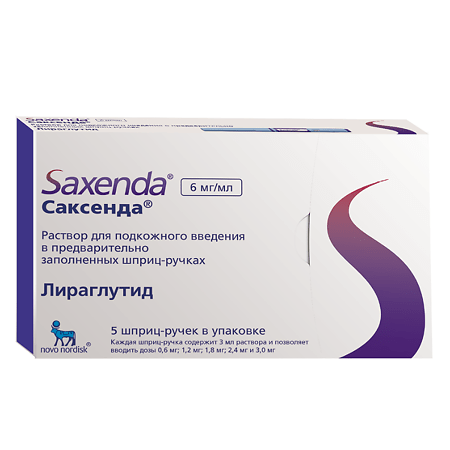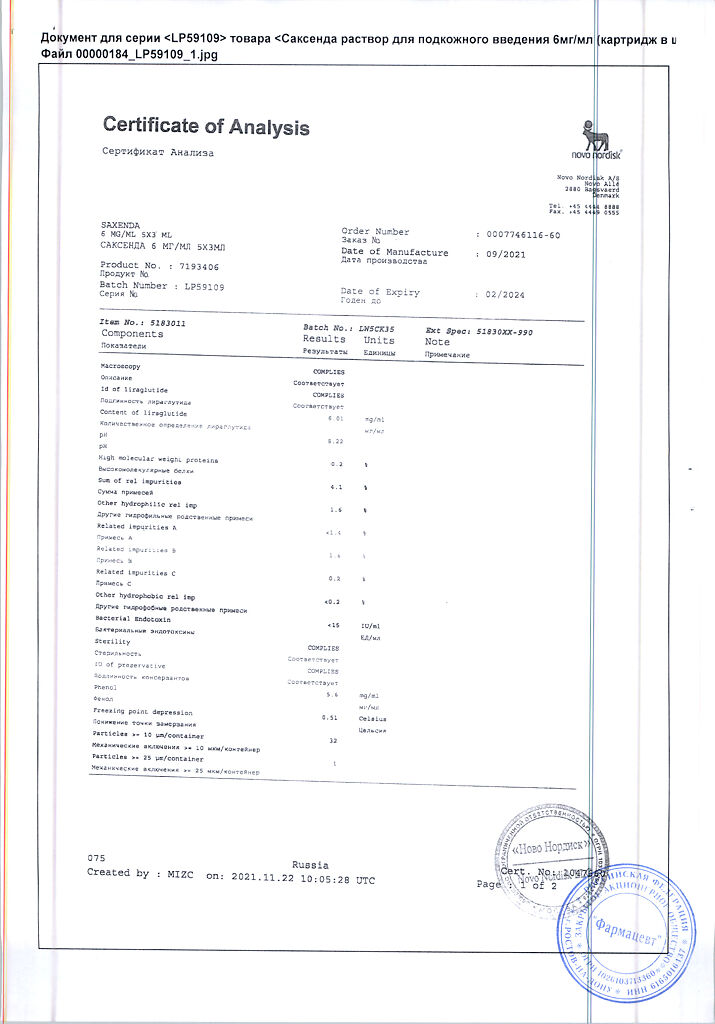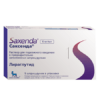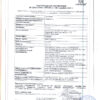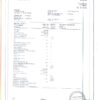No products in the cart.
Saxenda, 6 mg/ml 3 ml cartridges in syringe pens 5 pcs
€1.00
Out of stock
(E-mail when Stock is available)
Description
Pharmacotherapeutic group
Hypoglycemic agent – analog of glucagon-like peptide-1 (GFP-1).
ATC code: A10BJ02.
Pharmacological properties
Pharmacodynamics
The active ingredient of Saxenda® – liraglutide – is an acylated analog of human GFP-1, produced by recombinant DNA biotechnology using Saccharomyces cerevisiae strain, which has 97% homology of the amino acid sequence to endogenous human GFP-1. Liraglutide binds to and activates the GFP-1 receptor (GFP-1P). Liraglutide is resistant to metabolic breakdown with a plasma half-life of 13 h after subcutaneous administration. The pharmacokinetic profile of liraglutide, which allows it to be administered to patients once daily, is the result of self-association, which results in delayed absorption of the drug; binding to plasma proteins; and resistance to dipeptidyl peptidase-4 (DFP-4) and neutral endopeptidase (NEP).
PPP-1 is a physiological regulator of appetite and food intake, and PPP-1P is located in several brain regions involved in appetite regulation. In animal studies, peripheral administration of liraglutide resulted in uptake in specific brain regions, including the hypothalamus, where liraglutide, through specific activation of GFP-1P, increased satiety signals and attenuated hunger signals, thereby leading to weight loss.
PPP-1R is also present in specific areas of the heart, blood vessels, immune system and kidneys. In experiments on mice with atherosclerosis, liraglutide prevented further development of aortic plaques and reduced inflammation in them. In addition, liraglutide had a favorable effect on plasma lipids. Liraglutide did not reduce the size of existing plaques.
Liraglutide reduces body weight in humans primarily by reducing the weight of adipose tissue. The decrease in body weight comes at the expense of decreased food intake. Liraglutide does not increase 24-hour energy expenditure. Liraglutide regulates appetite by increasing the feeling of a full stomach and satiety, while weakening the feeling of hunger and reducing anticipated food intake.
Liraglutide stimulates insulin secretion and reduces unnecessarily high glucagon secretion in a glucose-dependent manner and improves pancreatic beta cell function, resulting in lower fasting and post-meal glucose concentrations. The mechanism of lowering glucose concentration also includes a slight delay in gastric emptying.
In long-term clinical trials (LC) with overweight and obese patients, use of Saxenda® in combination with a low-calorie diet and increased physical activity resulted in significant weight loss.
Effects on appetite, caloric intake and energy expenditure, gastric emptying, and glucose concentration on an empty stomach and after meals
. The pharmacodynamic effects of liraglutide were studied in a five-week pharmacological QI involving 49 obese patients (body mass index (BMI) 30-40 kg/m2) without diabetes mellitus (DM).
Appetite, caloric intake, and energy expenditure
The reduction in body weight with Saxenda® is thought to be associated with regulation of appetite and food intake. Appetite was assessed before and within 5 h after a standardized breakfast; unrestricted food intake was assessed at a subsequent lunch. Compared with placebo, Saxenda® increased feeling of fullness and gastric filling after a meal and decreased feeling of hunger and estimated amount of estimated food intake, as well as decreased unrestricted food intake. There was no therapy-related increase in 24-hour energy expenditure when assessed with the respiratory chamber.
Gastric Emptying
The use of Saxenda® resulted in a slight delay in gastric emptying during the first hour after ingestion, resulting in a decreased rate of glucose elevation as well as a decreased total blood glucose concentration after ingestion.
The fasting and postmeal glucose, insulin, and glucagon concentrations
The fasting and postmeal glucose, insulin, and glucagon concentrations were assessed before and within 5 h after standardized meal intake. Compared to placebo, Saxenda® decreased fasting and postprandial glucose concentrations (AUC0-60 min) during the first hour after a meal, and decreased the 5-hour AUC of glucose and the rising glucose concentration (AUC0-300 min). In addition, compared to placebo, Saxenda® decreased postprandial glucagon (AUC0-300 min) and insulin (AUC0-60 min) concentrations and incremental insulin concentration (iAUC0-60 min) after a meal.
The fasting glucose and insulin concentrations and incremental glucose and insulin concentrations were also assessed during an oral glucose tolerance test (IGT) with 75 g glucose before therapy and after 1 year of therapy in 3731 overweight and obese patients and with the presence or absence of prediabetes. Compared to placebo, Saxenda® decreased fasting glucose concentration and increasing glucose concentration. The effect was more pronounced in patients with prediabetes. In addition, compared to placebo, Saxenda® decreased fasting insulin concentration and increased increasing insulin concentration.
After 160 weeks of continued therapy with liraglutide 3.0 mg, the AUC of plasma glucose decreased, whereas it remained unchanged with placebo. Additionally, insulin AUC remained relatively stable during the 160-week period of liraglutide 3.0 mg treatment, whereas a decrease was observed with placebo. All effects of the therapy studied were statistically significant in favor of liraglutide 3.0 mg.
Impactand on fasting glucose concentration and rising glucose concentration in overweight and obese patients with type 2 diabetes mellitus (DM2)
. Compared to placebo, Saxenda® reduced fasting glucose concentration and mean rising postprandial glucose concentration (90 minutes after a meal, mean value for 3 meals per day).
Pancreatic Beta Cell Function
Consecutive trials of up to one year with Saxenda® in patients with overweight and with or without DM have demonstrated improved and maintained pancreatic beta cell function. This was shown using measurement methods such as the homeostatic beta cell function assessment model (NOMA-B) and the ratio of proinsulin to insulin concentrations.
Clinical efficacy and safety
The efficacy and safety of Saxenda® for long-term weight correction in combination with a low-calorie diet and increased physical activity was studied in 4 randomized, double-blind, placebo-controlled phase 3 SCALE studies including a total of 5358 adult patients.
Body weight
. Compared to placebo, Saxenda® achieved greater reductions in body weight in obese/overweight patients in all study groups, including those with or without prediabetes, DM2 and moderate to severe obstructive sleep apnea. In addition, among the study population, a greater proportion of patients achieved weight reductions ≥ 5% and ˃ 10% with Saxenda® compared to placebo. Significant weight loss was also observed in a CI in which patients achieved an average weight loss of 6.0% using a low-calorie diet for 12 weeks prior to treatment with Saxenda®. In this study, more patients maintained the weight loss achieved before treatment with Saxenda® compared to placebo (81.4% and 48.9%, respectively).
In a KI of 160 weeks, patients who received Saxenda® achieved greater weight loss than patients who received placebo. Most of the weight loss occurred in the first year and was maintained for 160 weeks.
In the 160-week KI, the mean percent change in body weight and the proportion of patients achieving weight loss from baseline to 160 weeks of at least 5% and more than 10% were also significant compared to placebo.
Weight loss after 12 weeks of therapy with Saxenda® (liraglutide 3.0 mg)
In two studies of 56 weeks, 67.5% and 50.4% of patients achieved weight loss of at least 5% after 12 weeks of therapy with Saxenda® at a dose of 3.0 mg. The average weight loss in these patients who completed the study was 11.2% compared to the baseline value. In patients who achieved a weight loss of less than 5% after 12 weeks of 3.0 mg therapy and completed the study (1 year), the mean weight loss was 3.8%.
Glycemic control
Liraglutide therapy significantly improved glycemic performance in the normoglycemic, prediabetic and DM2 subpopulations.
D2 developed in 0.2% of patients treated with Saxenda® compared with 1.1% in the placebo group. 69.2% of patients with prediabetes reversed this condition with Saxenda® compared to 32.7% in the placebo group. At week 160, 3% of patients who received Saxenda® and 11% of patients who received placebo were diagnosed with DM2 while continuing treatment. Compared to placebo, the time to DM2 development was 2.7 times longer with liraglutide 3.0 mg and the relative risk (RR) of DM2 development with liraglutide was 0.2. At week 160 in the liraglutide 3.0 mg group, 65.9% of patients with prediabetes reversed this condition to normoglycemia compared with 36.3% in the placebo group.
In one study, 69.2% and 56.5% of obese and DM2 patients who received Saxenda® achieved target HbA1c values of ˂ 7% and ≤6.5%, respectively, compared with 27.2% and 15.0% in patients who received placebo.
Cardiometabolic parameters
Compared with placebo, Saxenda® significantly improved systolic blood pressure (BP), waist circumference and fasting lipid concentration.
In a 160-week CI, the mean reduction in waist circumference was 8.2 cm with Saxenda® and 4.0 cm with placebo; the reduction in systolic and diastolic BP was 4.3 mm Hg and 1.5 mm Hg with Saxenda® and 2.7 mm Hg and 1.8 mm Hg with placebo.Hg when using placebo, respectively; decrease of LDL cholesterol concentration was 3.1 mmol/L when using Saxenda® and 0.7 mmol/L when using placebo; increase of HDL cholesterol concentration was 2.3 mmol/L when using Saxenda® and 0.5 mmol/L when using placebo.
The Apnea-Hypnea Index (AHI)
Compared with placebo, there was a significant reduction in the severity of obstructive sleep apnea with Saxenda®, as assessed by the change in AHI relative to baseline.
Immunogenicity
Due to the potential immunogenic properties of protein and peptide drugs, patients may develop antibodies to liraglutide after therapy with Saxenda®. In the CI, 2.5% of patients treated with Saxenda® developed antibodies to liraglutide. The formation of antibodies did not result in a decrease in the effectiveness of Saxenda®.
Evaluation of cardiovascular events
The major cardiovascular events (MACE) were evaluated by a panel of external independent experts and defined as nonfatal myocardial infarction, nonfatal stroke, and cardiovascular death. In 5 double-blind controlled phase 2 and 3 CIs with Saxenda®, there were 6 BSSS in patients receiving Saxenda® and 10 BSSS in patients receiving placebo. The OR with 95% CI was 0.33 for Saxenda® versus placebo. In the phase 3 CI, the mean increase in heart rate (HR) was 2.5 beats per minute in patients receiving Saxenda®. The greatest increase in HR was observed after 6 weeks of therapy. This increase was reversible and disappeared after discontinuation of liraglutide therapy.
A multicenter, placebo-controlled, double-blind study, Effect and Effects of Liraglutide in Diabetes Mellitus: Assessment of Cardiovascular Risks (LEADER®), was conducted.
Liraglutide 1.8 mg also significantly reduced the risk of advanced BSSS (primary BSSS, unstable angina leading to hospitalization, myocardial revascularization, or hospitalization for heart failure) and other secondary end points.
Children and adolescents
. In a double-blinded CI comparing the efficacy and safety of Saxenda® versus placebo for weight loss in obese adolescents aged 12 years and older, Saxenda® was superior to placebo in reducing the standard deviation of BMI (measured to assess weight loss) after 56 weeks of treatment. More patients achieved ≥5% and ≥10% reductions in BMI on liraglutide therapy than patients receiving placebo, with greater reductions in mean BMI and body weight. At 26 weeks of follow-up without the drug, there was a recovery in body weight with Saxenda® compared to placebo (assessed as change in standard deviation of BMI)
Based on tolerability, for most patients (82.4%) the drug dose was increased and they continued to receive the 3.0 mg dose; for the remaining patients the dose was increased and they continued to receive the drug at a dose range of 2.4 mg to 0.6 mg.
Patient-determined scores
The drug Saxenda®, compared with placebo, improved patient-determined scores on several measures. There was a significant improvement in overall scores on the Simplified Weight-for-Life Questionnaire (IWQoL-Lite) and all scales of the SF-36, indicating a positive effect on the physical and psychological components of quality of life.
Pharmacokinetics
Intake
. Absorption of liraglutide after subcutaneous administration is slow, with a time to reach maximum concentration (tmax) of about 11 h after administration. In obese patients (BMI 30-40 kg/m2) the average equilibrium concentration of liraglutide (AUCτ/24) reaches approximately 31 nmol/L after administration of 3.0 mg liraglutide. In the dose range of 0.6 mg to 3.0 mg, liraglutide exposure increases in proportion to the dose. The absolute bioavailability of liraglutide after subcutaneous administration is approximately 55%.
Distribution
The average apparent volume of distribution after subcutaneous administration of liraglutide at a dose of 3.0 mg is 20-25 L (in subjects with a body weight of approximately 100 kg). Liraglutide is largely bound to plasma proteins (> 98%).
Metabolism
At 24 h after a single dose of [3H]liraglutide in healthy volunteers, unchanged liraglutide remained the major component in plasma. Two metabolites (≤ 9% and ≤ 5% of total plasma radioactivity) were detected.
Elimation
Liraglutide is metabolized endogenously like large proteins without involvement of any specific organ as the main excretion route. After a dose of [3H]-liraglutide was administered, unaltered liraglutide was not detected in the urine or feces. Only a minor portion of the administered radioactivity in the form of liraglutide metabolites was excreted by the kidneys or through the intestine (6% and 5%, respectively). The radioactive substances were excreted by the kidneys or through the intestine mainly during the first 6-8 days and represent 3 metabolites.
The average clearance after subcutaneous administration of 3.0 mg of liraglutide is approximately 0.9 1.4 L/h, with a half-life of approximately 13 h.
Special patient groups
Patients Elderly patients
There is no need to adjust the dose for age. According to the results of a population pharmacokinetic analysis in overweight and obese patients aged 18 – 82 years, age had no clinically significant effect on the pharmacokinetics of liraglutide when administered subcutaneously at a dose of 3.0 mg.
Gender
Based on population pharmacokinetic analysis data, women had a 24% lower body weight-adjusted clearance of liraglutide after subcutaneous administration at the 3.0 mg dose than men. Based on the drug response data, no gender-specific dose adjustment is required.
Ethnicity
. According to a population-based pharmacokinetic analysis that included data from studies in overweight and obese patients of Caucasian, Negro, Asian, and Hispanic racial groups, ethnicity had no clinically significant effect on the pharmacokinetics of liraglutide when administered subcutaneously at the 3.0 mg dose.
Body weight
Liraglutide exposure decreases with increasing baseline body weight. Use of liraglutide at a dose of 3.0 mg daily provides adequate exposure in the body weight range of 60-234 kg, according to the evaluation of the response to systemic exposure to the drug in the CI. Exposure to liraglutide in patients with body weights greater than 234 kg was not studied.
Patients with hepatic impairment
The pharmacokinetics of liraglutide were evaluated in patients with varying degrees of hepatic impairment in a single-dose (0.75 mg) study. A 13-23% reduction in liraglutide exposure was observed in patients with mild to moderate hepatic impairment and a significant reduction in liraglutide exposure (44%) in patients with severe hepatic impairment (> 9 Child-Pugh score) compared to healthy volunteers.
Patients with renal impairment
In a single-dose study (0.75 mg), liraglutide exposure was lower in patients with renal impairment compared to individuals with normal renal function. Exposure to liraglutide was lower by 33%, 14%, 27%, and 26%, respectively, in patients with mild (creatinine clearance (CK) 50 to 80 ml/min), moderate (CK 30 to 50 ml/min), severe (CK < 30 ml/min), and in patients with end-stage renal failure requiring hemodialysis.
Children and adolescents
The pharmacokinetic properties of liraglutide 3.0 mg were evaluated in clinical studies in obese adolescents aged 12 years to 18 years (134 patients, body weight 62-178 kg). Exposure to liraglutide in adolescents aged 12 to 18 years was comparable to that observed in adult obese patients.
Pharmacokinetic properties were also evaluated in a clinical pharmacology study involving obese children aged 7 to 11 years (13 patients, body weight 54-87 kg). Exposure to liraglutide 3.0 mg in children aged 7 to 11 years was comparable to that observed in adult patients after adjustment for body weight.
Indications
Indications
Adults
The Saxenda® drug is indicated as an adjunct to a low-calorie diet and vigorous exercise for long-term use to correct body weight in adult patients with BMI:
– ⥠30 kg/m2 (obesity) or
– ⥠27 kg/m2 to < 30 kg/m2 (overweight) with at least one associated overweight comorbidity, such as prediabetes, type 2 diabetes, arterial hypertension, dyslipidemia or obstructive sleep apnea syndrome.
Adolescents
The drug Saxenda® may be used as a supplement to a healthy diet and increased physical activity to correct body weight in adolescents aged 12 years and older:
– body weight over 60 kg and
– obesity (BMI corresponding to â¥30 kg/m2 for adults according to international thresholds) *
*The IOTF BMI threshold for obesity based on sex between 12 and 18 years of age.
Table 1. IOTF BMI threshold value for obesity as a function of sex at ages 12 to 18 years.
Age
(number of years)
Body mass index
30 kg/m
Male sex
Female gender
12
26.02
26.67
12.5
26.43
27.24
13
26.84
27.76
13.5
27.25
28.20
14
27.63
28.57
14.5
27.98
28.87
15
28.30
29.11
15.5
28.60
29.29
16
28.88
29.43
16.5
29.14
29.56
17
29.41
29.69
17.5
29.70
29.84
18
30.00
30.00
Active ingredient
Active ingredient
Composition
Composition
How to take, the dosage
How to take, the dosage
Dose
Weeks
Dose escalation over 4 weeks
0.6 mg
1
1.2 mg
1
1.8 mg
1
2.4 mg
1
Dry mouth, dyspepsia, gastritis, gastroesophageal reflux, upper abdominal pain, flatulence, belching, abdominal bloating – Often
/p>
Pancreatitis***, delayed gastric emptying**** – Infrequent
Liver and biliary tract disorders
Cholecithiasis*** – Often
Cholecystitis*** – Infrequent
Skin and subcutaneous tissue disorders
Urticaria – Infrequent
Renal and urinary tract disorders
Acute renal failure, impaired renal function – Rarely
General disorders and disorders at the injection site
Reactions at the injection site, asthenia**, fatigue** – Often
/p>
Malaise** – Infrequent
Laboratory Methods of Investigation
Increased lipase, increased amylase activity – Often
Interaction
Interaction
Special Instructions
Special Instructions
Contraindications
Contraindications
Side effects
Side effects
Overdose
Overdose
Pregnancy use
Pregnancy use
Additional information
| Shelf life | 30 months. Do not use after the expiration date on the syringe pen label and packaging. |
|---|---|
| Conditions of storage | Keep out of reach of children. Store at 2 ° C to 8 ° C (in the refrigerator), but not near the freezer. Do not freeze. Store the used syringe-pen with the preparation at the temperature not more than 30°С or in a refrigerator (from 2°С to 8°С). Do not freeze. Use within 1 month. Close the syringe-pen with a cap to protect it from light. |
| Manufacturer | Novo Nordisk A/S, Denmark |
| Medication form | solution |
| Brand | Novo Nordisk A/S |
Related products
Buy Saxenda, 6 mg/ml 3 ml cartridges in syringe pens 5 pcs with delivery to USA, UK, Europe and over 120 other countries.

